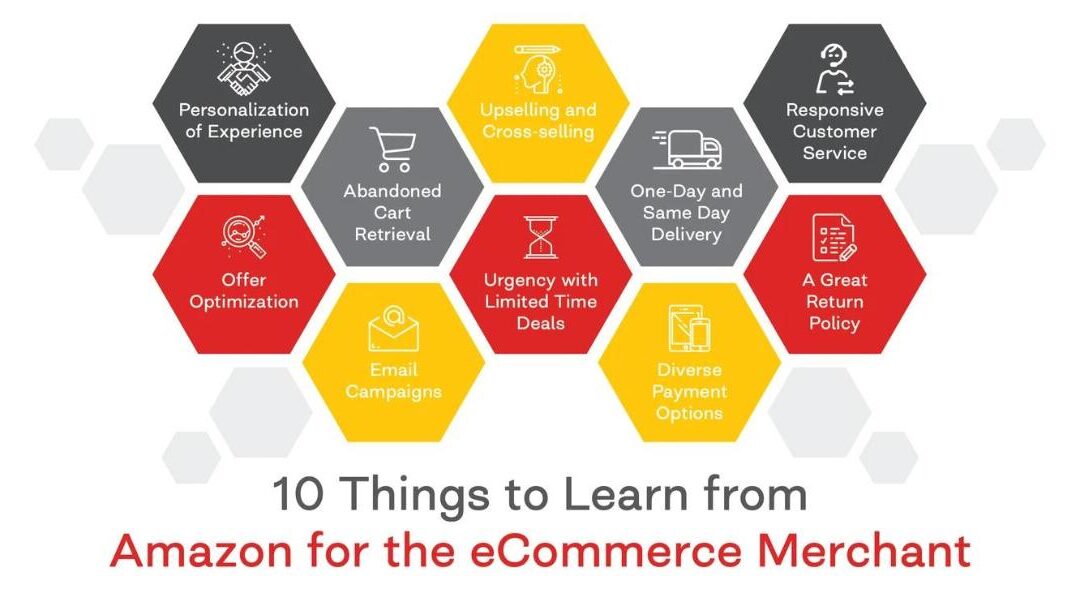Starting out as an eCommerce business owner can be both challenging and rewarding. You need to always have in place a strategic marketing plan and find ways to execute it to achieve the figures you have forecast for each quarter. It is all fine and dandy as long as you keep your sales up.
But there are challenges in the form of market forces like aggressive competition and disruptions like the recent global pandemic that are bound to slow you down. During such times, you need to stop and rethink your strategy. And while you are at it, it is a good idea to learn from Amazon.
Amazon has been dealing with the daily challenges of the eCommerce business for the last 28 years. They are the industry leaders in the D2C sector and you can learn a few things from them that are useful to implement in your own eCommerce strategy. Here are 10 things you can learn from Amazon that will help your business grow.
#1 Personalization of Experience
Each Amazon customer is treated with an exclusive shopping experience. From the products recommended on their homepage to the offers and rewards sent over email, Amazon personalizes its CX to the tee.
For instance, if a customer has ordered a string of non-fiction books, Amazon recommends more non-fiction books that match the customer’s interests. If a customer has been ordering electronics, Amazon recommends headphones and other accessories to her the next time she visits the store.
Personalization in your eCommerce store is about reading your customers’ shopping habits and giving them more of what they usually purchase rather than offering them a generic experience. You can personalize product recommendations, offers on email and SMS, and upselling suggestions, to suit your customers likes.
When you offer a personalized shopping experience to your customers, you will retain those customers for a longer period, as they find it enjoyable to shop with you.
#2 Offer Optimization
When you open your Amazon account to buy something, you will find that all products are made available at a certain percent off on their retail price. It makes one wonder, how does Amazon make any money at all after giving away all of its products at a discounted price.
In fact, Amazon makes a sizable profit on every purchase and their margins are consistently high. The secret sauce to their cooking up those many offers is called offer optimization.
With offer optimization, Amazon has figured out how to create the right offer for the right customer at the right time. With personalized offers, they not only drive sales, but also hit the right margin that returns them the optimal profit on those items.
You can optimize offers on your web store with the help of an offer optimization tool like Qubriux on Shopify. It creates offers that result in a win-win scenario for both you and your customer.
#3 Abandoned Cart Retrieval
Amazon has mastered their customer engagement when it comes to retrieving abandoned carts. If a shopper places a product in their Amazon cart and doesn’t purchase it, Amazon will follow them all over the internet and retarget them with ads for that item. Relentlessly.
Amazon seems sure that the shopper will have no other choice but to buy the item from them – they just have to get them to click the button. From what we have seen, Amazon employs this strategy exclusively. They don’t even bother to send abandoned cart emails.
You could follow this example and place personalized pay-per-click ads for your customers on the web. If your customer has already bought the item, then they won’t click on the ad and you don’t have to pay for it. Additionally, you could also send emails to your customers to retrieve abandoned carts, which results in an average 19% retrieval rate.
Also read: How To Reduce E-Commerce Cart Abandonment?
#4 Email Campaigns
Short of praising Amazon, studying the practical implications of their innovation in email marketing is an absolute thrill.
In the average eCommerce business, email marketing tends to rely upon promotional offers and newsletters. Rewards and discounts are often a long shot attempt to get your customers to buy.
Amazon takes an approach that is entirely different from the rest of the field. Every email is personalized using every piece of information they collect about their users: viewing behavior, past purchase history, average spend, location, age, gender, browsing history and so on.
They hyper-personalize their email campaigns such that no two customers get the same email offer or marketing message. They make it convenient for each customer to get from what they want to buy to purchase the item fairly easily.
#5 Upselling and Cross-selling
Amazon are market leaders on upselling and cross-selling. The Amazon homepage is full of loaded information and links to sell more to a customer. Their recommendation engine suggests a row of items under the heading “New For You”. And it does more:
For instance, if I had looked up a heart rate monitor last week, but did not add it to cart, I would see a collection of heart-rate monitors on my Amazon homepage under the heading “More Items To Consider”.
They also showcase a link to my browsing history to let me know that they have been watching my shopping habits and are ready with my viewing history. Thus enabling me to get back to an item of interest and make a purchase. All of which account for a higher chance of upselling.
Just before checking out, Amazon recommends items that go with what I am about to purchase. They don’t miss an opportunity to pitch a sale. And they have designed their web store to aggressively serve this goal.
Amazon has reported that cross-selling and upselling makes up as much as 35% of their revenue. Whereas product recommendations are responsible for an average of 10-30% of their revenues.
#6 Urgency with Limited Time Deals
Amazon has mastered manipulating user behavior with tactically created deals. They do this by offering the product you want at an offer price you love, but for a limited time only or for a limited number of units. You often see the appendix, “Only 2 Left in Stock” just beneath the product picture.
Creating limited-time deals is a great way to convince your customers to buy the product rather than let them drag their feet about the purchase.
In reality, there may be more than just 2 items left in stock. But the urgency created by this small tactical announcement results in an uptick in sales for that product. All of a sudden, a slow moving product sees a peak in sales purely due to the sense of urgency created by Amazon.
Amazon has dedicated pages titled “Today’s Deals” and “Lightning Deals” for customers to make use of rare offers that are not available otherwise.
#7 One-Day and same day Delivery
What makes Amazon so great is the execution of its product delivery. Not only do they let you keep track of the delivery status, but they also offer quick delivery on fast-moving products. They came up with same-day and one-day delivery to gratify their customers yearning to enjoy their purchases fresh from the store.
You may not be able to offer such quick turnaround times with your delivery. But you could keep your customers informed on the point of delivery. When your customers are up-to-date with the point-to-point status of their package, they feel more reassured with their shopping experience. This will instill a lot of trust in your brand.
Amazon has become synonymous with online shopping purely based on its ability to deliver products on time. You can keep your customers happy by improving the time and reliability of your delivery mechanism.
#8 Diverse Payment Options
When it comes to making a payment on Amazon, they lead with their own payment gateway, Amazon Pay. In addition, they offer their customers diverse payment options to give every item the best opportunity to convert into a sale. They accept cash payment on delivery, credit/debit cards, internet banking, a unified payment interface, and even PayPal Key.
These several methods of payment help the customer choose an option convenient to them. Another stellar sales tactic by Amazon involves the saving of credit card information that allows the user to activate a “one-click” purchase, with the user spending practically no time at checkout.
You could also offer your customers the option to save their credit card information on your web store so that they get to check out quickly the next time they shop with you. This accounts for a hassle-free shopping experience and an overall improved customer engagement.
#9 Responsive Customer Service
When you visit the Amazon Customer Service page with a query on your purchase, you have two options to reach them: ‘Chat Right Now’ and ‘Have Us Call You’. Every region that Amazon serves has a dedicated customer service phone number that customers can use to reach out to a representative.
Being able to speak to an actual person rather than facing automated voice responses instills a lot of confidence in shoppers.
In the D2C business, brands that have robust customer care service tend to outperform those that don’t. Your customers are paying you based on information they see on your website. And if something is not up to their expectations, they need to be able to reach you.
One of the first things you need to do is set up a chat option on your website and display a phone number for your customers to reach you when they have a query regarding their order.
#10 A Great Return Policy
Amazon offers different return policies for different categories. For their Digital Devices category, they offer a 10-day-refund-only policy and for Mobiles and Computers, they offer a 10-day-returnable policy. On items like video games and Kindle books, they offer a 7-day-return/replacement policy, while a few items fall under the non-returnable category.
Offering a great return policy to your customers increases their lifetime value with you. Customers who are happy to get a return on an item that they accidentally purchased or one that did not meet their expectations are sure to come back to your store for more. It simply enhances your reliability with them and their shopping experience with you.
Well, these were the 10 things you, as an eCommerce business owner, can learn from Amazon. If you have a thought to share, write to us at cs@qubriux.com. If you want to set your store up with cutting-edge eCommerce capabilities visit Qubriux eCommerce at www.qubriux.com
To download Qubriux on the Shopify app store click on https://apps.shopify.com/qubriux
Related Read:
How To Reduce E-Commerce Cart Abandonment?


